The Relationship between Resting Metabolic Rate and Body Composition in People Living with Overweight and Obesity
Abstract
:1. Introduction
1.1. Overview of Overweight and Obesity Epidemic
1.2. Understanding RMR and Its Measurement Techniques
1.3. Factors Correlated with RMR and Their Significance
2. Materials and Methods
2.1. Patients (Inclusion and Exclusion Criteria)
- Provision of patient’s consent after being informed prior to any data collection and analysis.
- Diagnosis of overweight or obesity, as determined by calculated BMI (criteria for overweight: 25–30 kg/m2, criteria for obesity: ≥30 kg/m2).
- Performance of all the examinations described in the study protocol (measurement of body composition by BIA, measurement of RMR via indirect calorimetry, measurement of liver fat by MRI) during the initial visit, prior to any weight loss intervention.
- Strict adherence to the requirements for the aforementioned measurements.
- Exclusion Criteria
- Any disorder that, in the investigator’s judgment, may jeopardize compliance with the measurements needed for the study.
2.2. Description of the Evaluation Performed
- Anthropometric measurements: height (cm) and weight (kg).
- Body composition analysis via bioelectrical impedance (BIA) using the TanitaTBF-300A analyzer, (Tanita Corporation, Tokyo, Japan) [41]. The following parameters were obtained from BIA: weight [kg], BMI (calculated as the ratio of body weight [kg] to the square of height [m2]), percentage of body fat [%], total body water (TBW) [%], body fat [kg], muscle tissue mass [kg], visceral fat level [kg], and BMR [kcal].
- RMR measurement via indirect calorimetry: The Cosmed FitMate system device, version 2.3, a validated and reliable tool for measuring oxygen consumption and RMR through indirect calorimetry in adults was utilized in this study [42]. The assessment occurred while participants were lying down in a well-ventilated and low-lit room with moderate temperature conditions. This examination was conducted in the morning following 7–9 h of sleep. Before the assessment, participants were given a few minutes to relax in a seated position to ensure optimal measurement conditions. Subsequently, they were instructed to wear a face mask provided by the FitMate system. The assessment lasted approximately 15 min, with the first 3 min discarded, and was carried out in a controlled environment to minimize external disturbances. Throughout the assessment process, an investigator or expert healthcare professional closely monitored the progress on the FitMate screen.
- Liver fat quantification via MRI: hepatic steatosis was assessed using a standardized MRI protocol, which included axial T1-weighted imaging from the abdominal–pelvic regions and axial proton density fat fraction (PDFF) imaging through the liver. MRI is recognized as the gold standard imaging technique for both qualitative and quantitative evaluation of hepatic steatosis [42]. The sensitivity and specificity of MRI for detecting histologically confirmed steatosis (≥5%) are well documented, ranging from 76.7% to 90.0% and 87.1% to 91%, respectively [43,44]. MRI measurements of liver fat provide valuable insight into abdominal or visceral fat, which includes adipose tissue located around vital organs such as the liver, stomach, and intestines. This type of fat correlates strongly with central obesity and metabolic complications, making it a critical factor in the study of obesity-related conditions [43].
2.3. Study Design
2.4. Statistical Analysis
3. Results
3.1. Descriptive Statistics
3.2. Correlation Analysis
3.3. Linear Regression Analysis
4. Discussion
5. Conclusions
Author Contributions
Funding
Institutional Review Board Statement
Informed Consent Statement
Data Availability Statement
Conflicts of Interest
References
- Panuganti, K.K.; Nguyen, M.; Kshirsagar, R.K. Obesity. In StatPearls; StatPearls Publishing: Treasure Island, FL, USA, 2024. [Google Scholar]
- Apovian, C.M. Obesity: Definition, Comorbidities, Causes, and Burden. Am. J. Manag. Care 2016, 22, s176–s185. [Google Scholar] [PubMed]
- Worldwide Trends in Underweight and Obesity from 1990 to 2022: A Pooled Analysis of 3663 Population-Representative Studies with 222 Million Children, Adolescents, and Adults. Lancet 2024, 403, 1027–1050. [CrossRef] [PubMed]
- Touloumi, G.; Karakosta, A.; Kalpourtzi, N.; Gavana, M.; Vantarakis, A.; Kantzanou, M.; Hajichristodoulou, C.; Chlouverakis, G.; Trypsianis, G.; Voulgari, P.V.; et al. High Prevalence of Cardiovascular Risk Factors in Adults Living in Greece: The EMENO National Health Examination Survey. BMC Public. Health 2020, 20, 1665. [Google Scholar] [CrossRef] [PubMed]
- Afshin, A.; Forouzanfar, M.H.; Reitsma, M.B.; Sur, P.; Estep, K.; Lee, A.; Marczak, L.; Mokdad, A.H.; Moradi-Lakeh, M.; Naghavi, M.; et al. Health Effects of Overweight and Obesity in 195 Countries over 25 Years. N. Engl. J. Med. 2017, 377, 13–27. [Google Scholar] [CrossRef] [PubMed]
- Sarwer, D.B.; Polonsky, H.M. The Psychosocial Burden of Obesity. Endocrinol. Metab. Clin. N. Am. 2016, 45, 677–688. [Google Scholar] [CrossRef]
- Dandgey, S.; Patten, E. Psychological Considerations for the Holistic Management of Obesity. Clin. Med. 2023, 23, 318–322. [Google Scholar] [CrossRef]
- Chung, W.K.; Leibel, R.L. Considerations Regarding the Genetics of Obesity. Obesity 2008, 16, S33–S39. [Google Scholar] [CrossRef]
- Schwartz, M.W.; Seeley, R.J.; Zeltser, L.M.; Drewnowski, A.; Ravussin, E.; Redman, L.M.; Leibel, R.L. Obesity Pathogenesis: An Endocrine Society Scientific Statement. Endocr. Rev. 2017, 38, 267–296. [Google Scholar] [CrossRef]
- Uranga, R.M.; Keller, J.N. The Complex Interactions Between Obesity, Metabolism and the Brain. Front. Neurosci. 2019, 13, 513. [Google Scholar] [CrossRef]
- Romieu, I.; Dossus, L.; Barquera, S.; Blottière, H.M.; Franks, P.W.; Gunter, M.; Hwalla, N.; Hursting, S.D.; Leitzmann, M.; Margetts, B.; et al. Energy Balance and Obesity: What Are the Main Drivers? Cancer Causes Control 2017, 28, 247–258. [Google Scholar] [CrossRef]
- Hill, J.O.; Wyatt, H.R.; Peters, J.C. Energy Balance and Obesity. Circulation 2012, 126, 126–132. [Google Scholar] [CrossRef] [PubMed]
- Hall, K.D.; Heymsfield, S.B.; Kemnitz, J.W.; Klein, S.; Schoeller, D.A.; Speakman, J.R. Energy Balance and Its Components: Implications for Body Weight Regulation. Am. J. Clin. Nutr. 2012, 95, 989–994. [Google Scholar] [CrossRef] [PubMed]
- Volp, A.C.P.; de Oliveira, F.C.E.; Alves, R.D.M.; Esteves, E.A.; Bressan, J. Energy Expenditure: Components and Evaluation Methods. Nutr. Hosp. 2011, 26, 430–440. [Google Scholar]
- McMurray, R.G.; Soares, J.; Caspersen, C.J.; McCurdy, T. Examining Variations of Resting Metabolic Rate of Adults: A Public Health Perspective. Med. Sci. Sports Exerc. 2014, 46, 1352–1358. [Google Scholar] [CrossRef] [PubMed]
- Ainsworth, B.E.; Haskell, W.L.; Whitt, M.C.; Irwin, M.L.; Swartz, A.M.; Strath, S.J.; O’Brien, W.L.; Bassett, D.R.J.; Schmitz, K.H.; Emplaincourt, P.O.; et al. Compendium of Physical Activities: An Update of Activity Codes and MET Intensities. Med. Sci. Sports Exerc. 2000, 32, S498–S504. [Google Scholar] [CrossRef]
- Astrup, A.; Gøtzsche, P.C.; van deWerken, K.; Ranneries, C.; Toubro, S.; Raben, A.; Buemann, B. Meta-Analysis of Resting Metabolic Rate in Formerly Obese Subjects. Am. J. Clin. Nutr. 1999, 69, 1117–1122. [Google Scholar] [CrossRef]
- Shetty, P. Energy Requirements of Adults. Public Health Nutr. 2005, 8, 994–1009. [Google Scholar] [CrossRef]
- Argyrakopoulou, G.; Fountouli, N.; Dalamaga, M.; Kokkinos, A. Revisiting Resting Metabolic Rate: What Is the Relation to Weight Fluctuations? Curr. Obes. Rep. 2023, 12, 502–513. [Google Scholar] [CrossRef]
- Ndahimana, D.; Kim, E.-K. Measurement Methods for Physical Activity and Energy Expenditure: A Review. Clin. Nutr. Res. 2017, 6, 68–80. [Google Scholar] [CrossRef]
- Reneau, J.; Obi, B.; Moosreiner, A.; Kidambi, S. Do We Need Race-Specific Resting Metabolic Rate Prediction Equations? Nutr. Diabetes 2019, 9, 21. [Google Scholar] [CrossRef]
- Manini, T.M.; Everhart, J.E.; Anton, S.D.; Schoeller, D.A.; Cummings, S.R.; Mackey, D.C.; Delmonico, M.J.; Bauer, D.C.; Simonsick, E.M.; Colbert, L.H.; et al. Activity Energy Expenditure and Change in Body Composition in Late Life. Am. J. Clin. Nutr. 2009, 90, 1336–1342. [Google Scholar] [CrossRef] [PubMed]
- Krems, C.; Lührmann, P.M.; Strassburg, A.; Hartmann, B.; Neuhäuser-Berthold, M. Lower Resting Metabolic Rate in the Elderly May Not Be Entirely Due to Changes in Body Composition. Eur. J. Clin. Nutr. 2005, 59, 255–262. [Google Scholar] [CrossRef] [PubMed]
- Cancello, R.; Soranna, D.; Brunani, A.; Scacchi, M.; Tagliaferri, A.; Mai, S.; Marzullo, P.; Zambon, A.; Invitti, C. Analysis of Predictive Equations for Estimating Resting Energy Expenditure in a Large Cohort of Morbidly Obese Patients. Front. Endocrinol. 2018, 9, 367. [Google Scholar] [CrossRef] [PubMed]
- Seagle, H.M.; Strain, G.W.; Makris, A.; Reeves, R.S. Position of the American Dietetic Association: Weight Management. J. Am. Diet. Assoc. 2009, 109, 330–346. [Google Scholar] [CrossRef] [PubMed]
- Lazzer, S.; Bedogni, G.; Lafortuna, C.L.; Marazzi, N.; Busti, C.; Galli, R.; Col, A.D.; Agosti, F.; Sartorio, A. Relationship between Basal Metabolic Rate, Gender, Age, and Body Composition in 8780 White Obese Subjects. Obesity 2010, 18, 71–78. [Google Scholar] [CrossRef]
- Gould, L.M.; Hirsch, K.R.; Blue, M.N.M.; Cabre, H.E.; Brewer, G.J.; Smith-Ryan, A.E. Effects of Adiposity and Body Composition on Adjusted Resting Energy Expenditure in Women. Am. J. Hum. Biol. 2022, 34, e23610. [Google Scholar] [CrossRef]
- Alhabeeb, H.; AlFaiz, A.; Kutbi, E.; AlShahrani, D.; Alsuhail, A.; AlRajhi, S.; Alotaibi, N.; Alotaibi, K.; AlAmri, S.; Alghamdi, S.; et al. Gut Hormones in Health and Obesity: The Upcoming Role of Short Chain Fatty Acids. Nutrients 2021, 13, 481. [Google Scholar] [CrossRef]
- Hagedorn, T.; Poggiogalle, E.; Savina, C.; Coletti, C.; Paolini, M.; Scavone, L.; Neri, B.; Donini, L.M. Indirect Calorimetry in Obese Female Subjects: Factors Influencing the Resting Metabolic Rate. World J. Exp. Med. 2012, 2, 58–64. [Google Scholar] [CrossRef]
- Nachmani, M.; Lahav, Y.; Zeev, A.; Grosman-Rimon, L.; Eilat-Adar, S. Weight Change Adjusted Equations for Assessing Resting Metabolic Rate in Overweight and Obese Adults. Obes. Res. Clin. Pract. 2021, 15, 221–226. [Google Scholar] [CrossRef]
- Müller, M.J.; Geisler, C.; Hübers, M.; Pourhassan, M.; Braun, W.; Bosy-Westphal, A. Normalizing Resting Energy Expenditure across the Life Course in Humans: Challenges and Hopes. Eur. J. Clin. Nutr. 2018, 72, 628–637. [Google Scholar] [CrossRef]
- Coppini, L.Z.; Waitzberg, D.L.; Campos, A.C.L. Limitations and Validation of Bioelectrical Impedance Analysis in Morbidly Obese Patients. Curr. Opin. Clin. Nutr. Metab. Care 2005, 8, 329–332. [Google Scholar] [CrossRef] [PubMed]
- Keys, A.; Taylor, H.L.; Grande, F. Basal Metabolism and Age of Adult Man. Metabolism 1973, 22, 579–587. [Google Scholar] [CrossRef] [PubMed]
- Müller, M.J.; Bosy-Westphal, A.; Kutzner, D.; Heller, M. Metabolically Active Components of Fat-Free Mass and Resting Energy Expenditure in Humans: Recent Lessons from Imaging Technologies. Obes. Rev. 2002, 3, 113–122. [Google Scholar] [CrossRef] [PubMed]
- Henes, S.T.; Johnson, A.; Toner, M.; Mamaril, K.; Kelkar, M.; Xiao, Y.; Warren, G.L. Assessing Resting Metabolic Rate in Overweight and Obese Adolescents With a Portable Indirect Calorimeter: A Pilot Study for Validation and Reliability. Nutr. Clin. Pract. 2016, 31, 355–361. [Google Scholar] [CrossRef] [PubMed]
- Rachakonda, V.P.; DeLany, J.P.; Kershaw, E.E.; Behari, J. Impact of Hepatic Steatosis on Resting Metabolic Rate and Metabolic Adaptation in Response to Intentional Weight Loss. Hepatol. Commun. 2019, 3, 1347–1355. [Google Scholar] [CrossRef] [PubMed]
- Armellini, F.; Robbi, R.; Zamboni, M.; Todesco, T.; Castelli, S.; Bosello, O. Resting Metabolic Rate, Body-Fat Distribution, and Visceral Fat in Obese Women. Am. J. Clin. Nutr. 1992, 56, 981–987. [Google Scholar] [CrossRef]
- Nielsen, S.; Hensrud, D.D.; Romanski, S.; Levine, J.A.; Burguera, B.; Jensen, M.D. Body composition and resting energy expenditure in humans: Role of fat, fat-free mass and extracellular fluid. Int. J. Obes. Relat. Metab. Disord. 2000, 24, 1153–1157. [Google Scholar] [CrossRef]
- Almajwal, A.M.; Abulmeaty, M.M.A. New Predictive Equations for Resting Energy Expenditure in Normal to Overweight and Obese Population. Int. J. Endocrinol. 2019, 2019, 5727496. [Google Scholar] [CrossRef]
- Bosy-Westphal, A.; Braun, W.; Schautz, B.; Müller, M.J. Issues in characterizing resting energy expenditure in obesity and after weight loss. Front. Physiol. 2013, 4, 47. [Google Scholar] [CrossRef]
- Nieman, D.C.; Austin, M.D.; Benezra, L.; Pearce, S.; McInnis, T.; Unick, J.; Gross, S.J. Validation of Cosmed’s FitMate in Measuring Oxygen Consumption and Estimating Resting Metabolic Rate. Res. Sports Med. 2006, 14, 89–96. [Google Scholar] [CrossRef]
- Li, Q.; Dhyani, M.; Grajo, J.R.; Sirlin, C.; Samir, A.E. Current Status of Imaging in Nonalcoholic Fatty Liver Disease. World J. Hepatol. 2018, 10, 530–542. [Google Scholar] [CrossRef] [PubMed]
- Lee, S.S.; Park, S.H.; Kim, H.J.; Kim, S.Y.; Kim, M.-Y.; Kim, D.Y.; Suh, D.J.; Kim, K.M.; Bae, M.H.; Lee, J.Y.; et al. Non-Invasive Assessment of Hepatic Steatosis: Prospective Comparison of the Accuracy of Imaging Examinations. J. Hepatol. 2010, 52, 579–585. [Google Scholar] [CrossRef] [PubMed]
- Qayyum, A.; Nystrom, M.; Noworolski, S.M.; Chu, P.; Mohanty, A.; Merriman, R. MRI Steatosis Grading: Development and Initial Validation of a Color Mapping System. AJR Am. J. Roentgenol. 2012, 198, 582–588. [Google Scholar] [CrossRef] [PubMed]
- Lührmann, P.M.; Herbert, B.M.; Neuhäuser-Berthold, M. Effects of Fat Mass and Body Fat Distribution on Resting Metabolic Rate in the Elderly. Metabolism 2001, 50, 972–975. [Google Scholar] [CrossRef]
- Verdich, C.; Barbe, P.; Petersen, M.; Grau, K.; Ward, L.; Macdonald, I.; Sørensen, T.I.A.; Oppert, J.-M. Changes in body composition during weight loss in obese subjects in the NUGENOB study: Comparison of bioelectrical impedance vs. dual-energy X-ray absorptiometry. Diabetes Metab 2011, 37, 222–229. [Google Scholar] [CrossRef]
- van Werven, J.R.; Marsman, H.A.; Nederveen, A.J.; Smits, N.J.; ten Kate, F.J.; Gulik, T.M.v.; Stoker, J. Assessment of Hepatic Steatosis in Patients Undergoing Liver Resection: Comparison of US, CT, T1-Weighted Dual-Echo MR Imaging, and Point-Resolved 1H MR Spectroscopy. Radiology 2010, 256, 159–168. [Google Scholar] [CrossRef]
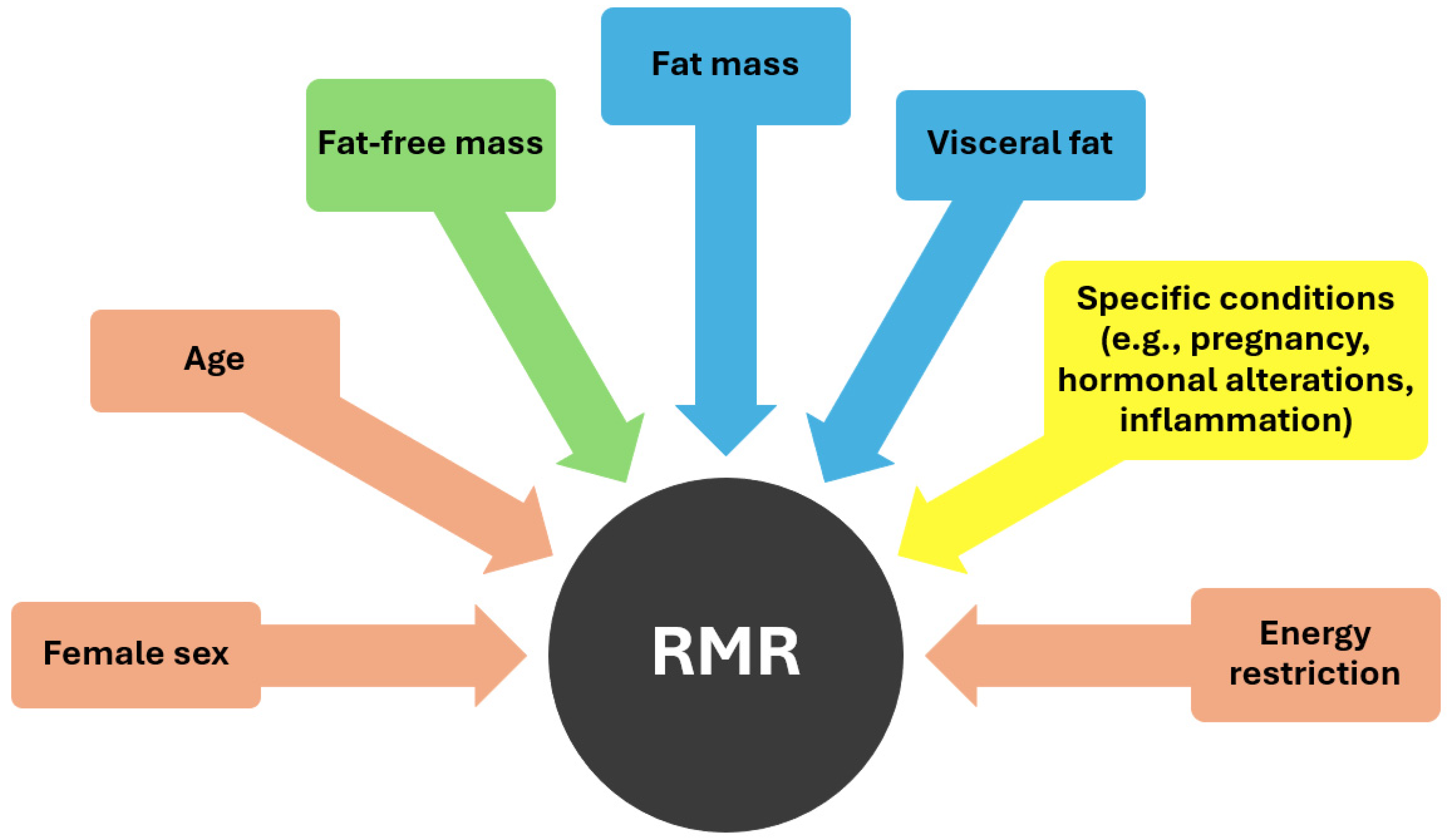
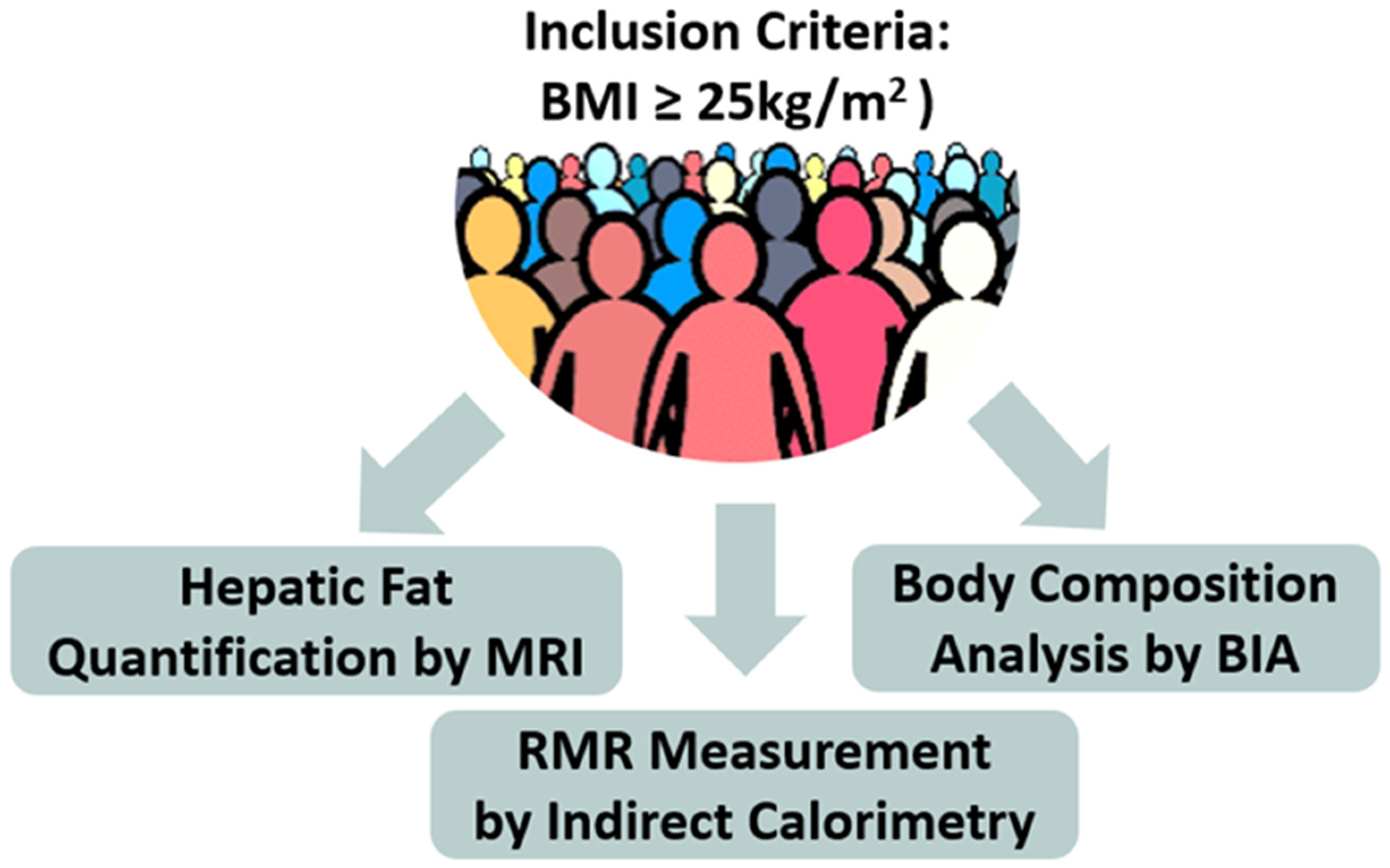
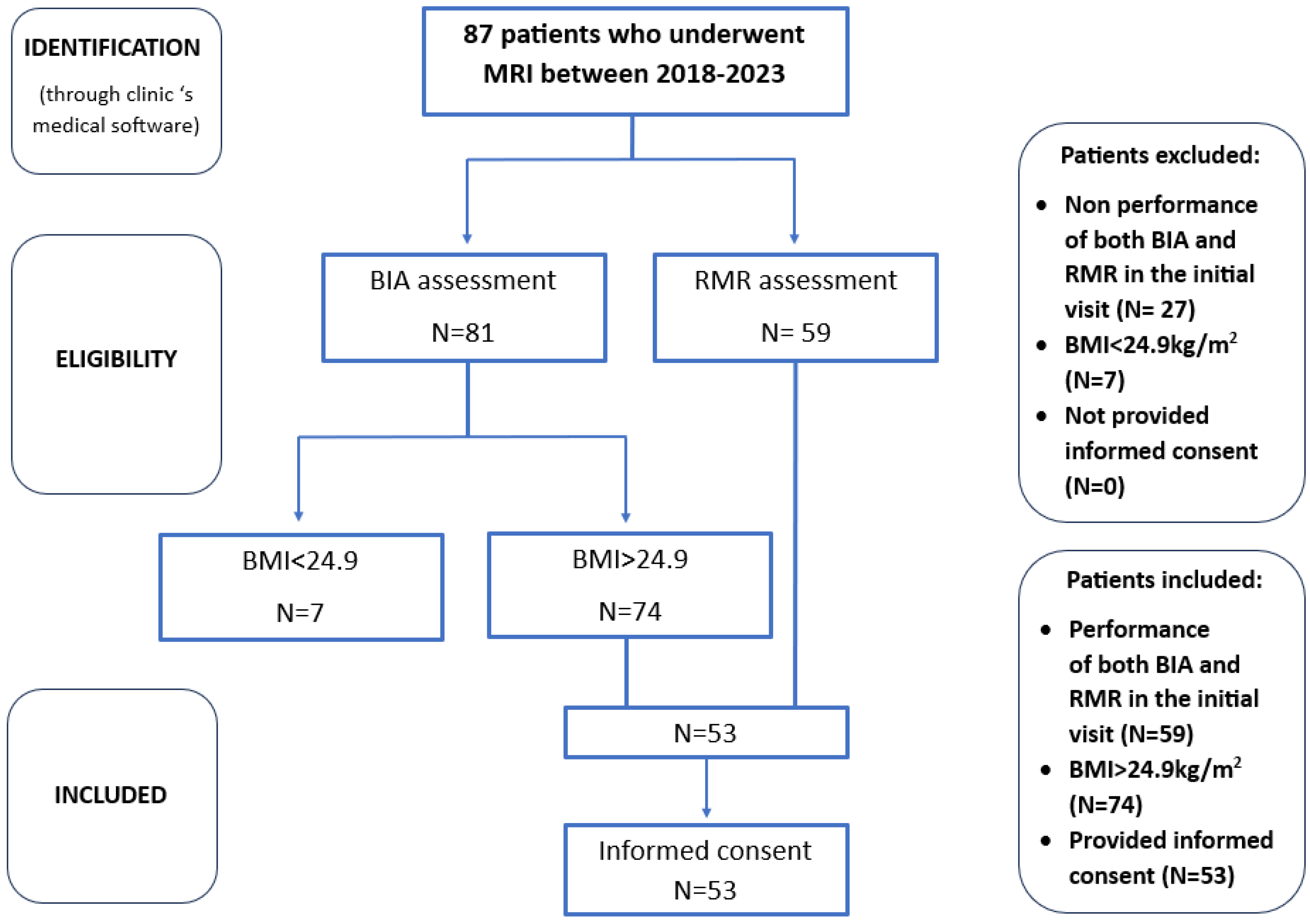


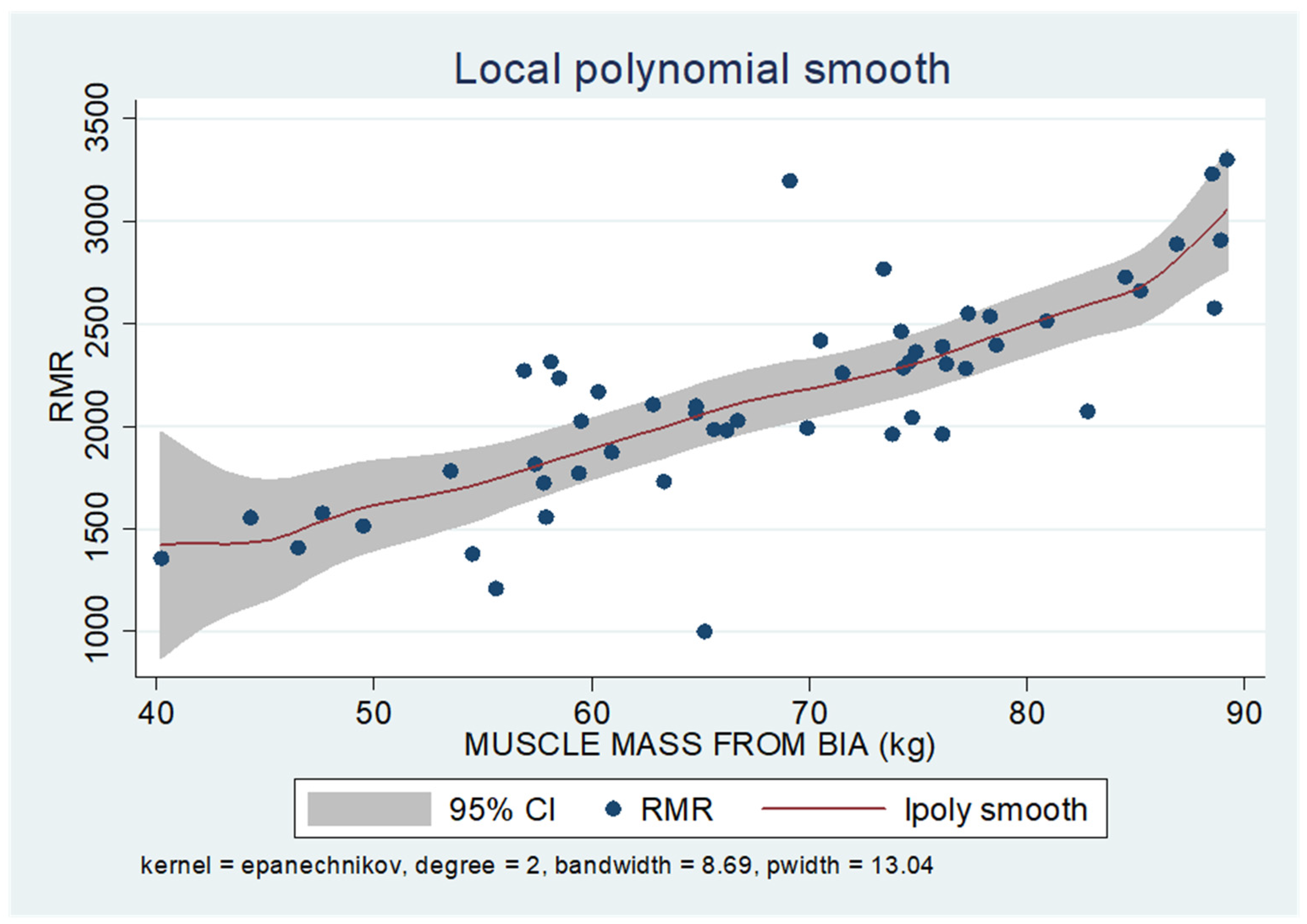
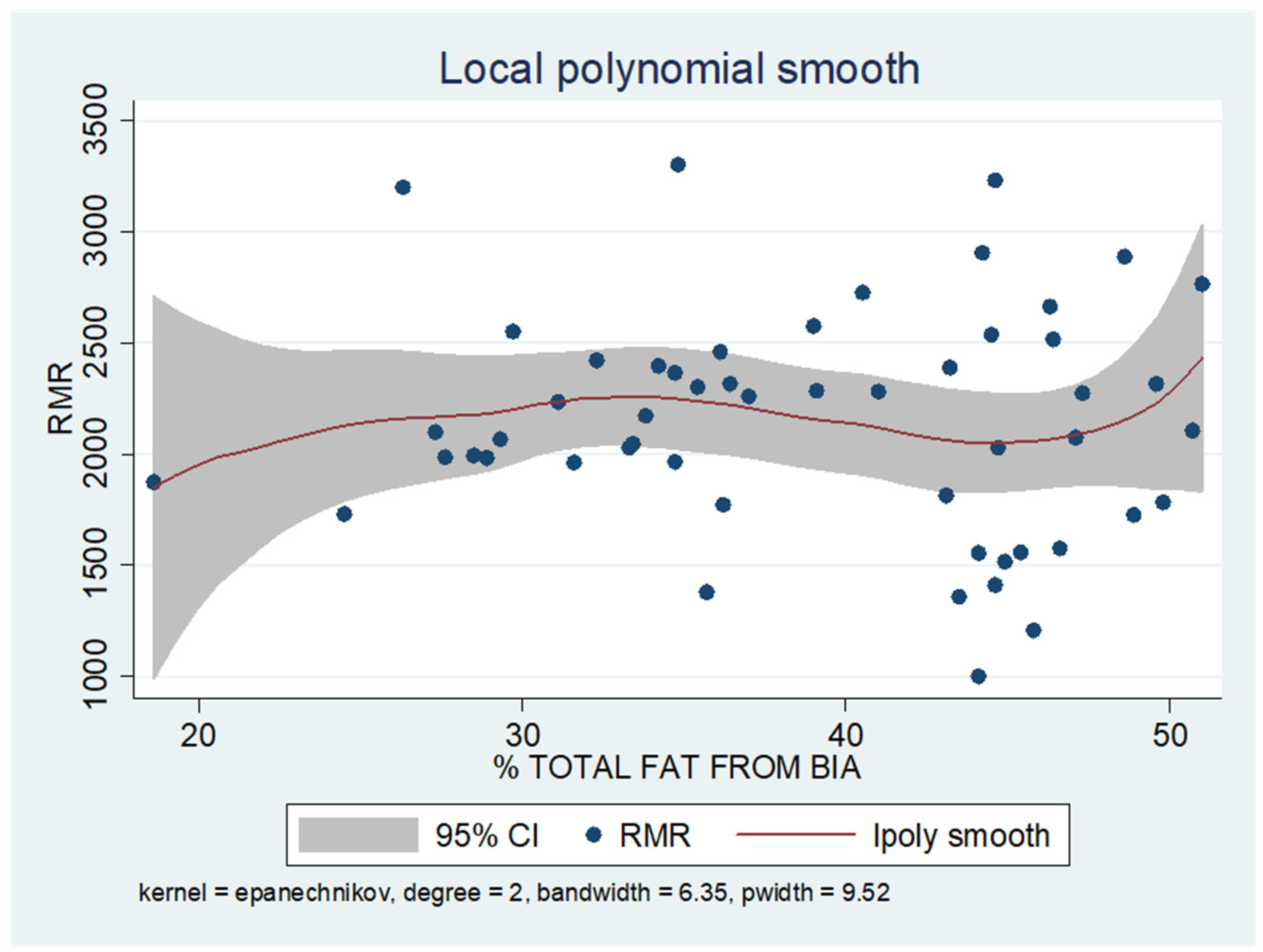
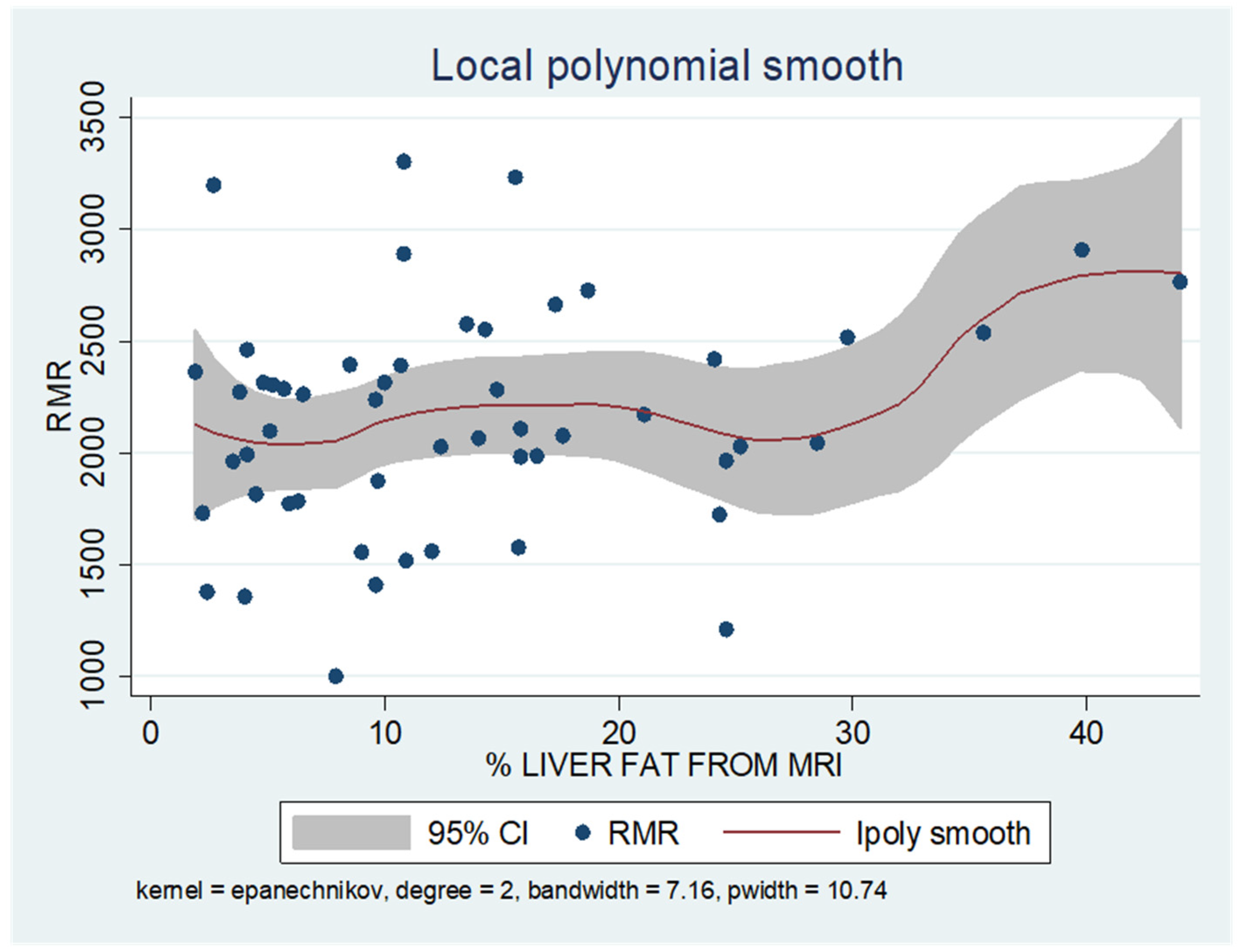
| Study Population Characteristics | Values |
|---|---|
| Age (years), mean ± SD | 48 ± 11 |
| Sex (% male) | 66 |
| BMI (kg/m2), median, 25th and 75th percentiles | 39 (33, 45) |
| Fat mass (%, from BIA), median, 25th and 75th percentiles | 39 (33, 45) |
| Fat mass (kg, from BIA), mean ± SD | 47 ± 17 |
| Muscle mass (kg, from BIA), mean ± SD | 68 ± 12 |
| Visceral fat (kg, from BIA), median, 25th and 75th percentiles | 24 (19, 28) |
| Liver fat (% from MRI), (median, 25th and 75th percentiles) | 13 ± 10 |
| Measured RMR (kcal), mean ± SD | 2125 ± 501 |
| Predicted RMR (kcal), mean ± SD | 2210 ± 432 |
| Study Population Characteristics | Coef. | p-Value |
|---|---|---|
| Age (years) | −0.39 | 0.004 * |
| BMI (kg/m2) | 0.43 | 0.0008 * |
| Fat mass (%, from BIA) | −0.06 | 0.69 |
| Muscle mass (kg, from BIA) | 0.78 | <0.001 * |
| Visceral fat (kg, from BIA) | 0.61 | <0.001 * |
| Liver fat (% from MRI) | 0.23 | 0.09 |
| Predicted RMR (kcal) | 0.78 | <0.001 * |
| Model 1 * | Model 2 ** | Model 3 *** | |
|---|---|---|---|
| Sex | −635.6 (−872.8, −398.4) | −582.3 (−809.6, −355.1) | −225.1 (−684.4, 234.3) |
| Age | - | −13.1 (−22.7, −3.4) | −5.5 (−14.2, 3.3) |
| Muscle mass | - | - | 24.1 (9.3, 39.0) |
| Fat mass | - | - | 7.4 (−12.2, 26.9) |
| Liver fat | - | - | −0.3 (−10.6, 9.9) |
Disclaimer/Publisher’s Note: The statements, opinions and data contained in all publications are solely those of the individual author(s) and contributor(s) and not of MDPI and/or the editor(s). MDPI and/or the editor(s) disclaim responsibility for any injury to people or property resulting from any ideas, methods, instructions or products referred to in the content. |
© 2024 by the authors. Licensee MDPI, Basel, Switzerland. This article is an open access article distributed under the terms and conditions of the Creative Commons Attribution (CC BY) license (https://creativecommons.org/licenses/by/4.0/).
Share and Cite
Gitsi, E.; Kokkinos, A.; Konstantinidou, S.K.; Livadas, S.; Argyrakopoulou, G. The Relationship between Resting Metabolic Rate and Body Composition in People Living with Overweight and Obesity. J. Clin. Med. 2024, 13, 5862. https://doi.org/10.3390/jcm13195862
Gitsi E, Kokkinos A, Konstantinidou SK, Livadas S, Argyrakopoulou G. The Relationship between Resting Metabolic Rate and Body Composition in People Living with Overweight and Obesity. Journal of Clinical Medicine. 2024; 13(19):5862. https://doi.org/10.3390/jcm13195862
Chicago/Turabian StyleGitsi, Evdoxia, Alexander Kokkinos, Sofia K. Konstantinidou, Sarantis Livadas, and Georgia Argyrakopoulou. 2024. "The Relationship between Resting Metabolic Rate and Body Composition in People Living with Overweight and Obesity" Journal of Clinical Medicine 13, no. 19: 5862. https://doi.org/10.3390/jcm13195862
APA StyleGitsi, E., Kokkinos, A., Konstantinidou, S. K., Livadas, S., & Argyrakopoulou, G. (2024). The Relationship between Resting Metabolic Rate and Body Composition in People Living with Overweight and Obesity. Journal of Clinical Medicine, 13(19), 5862. https://doi.org/10.3390/jcm13195862





